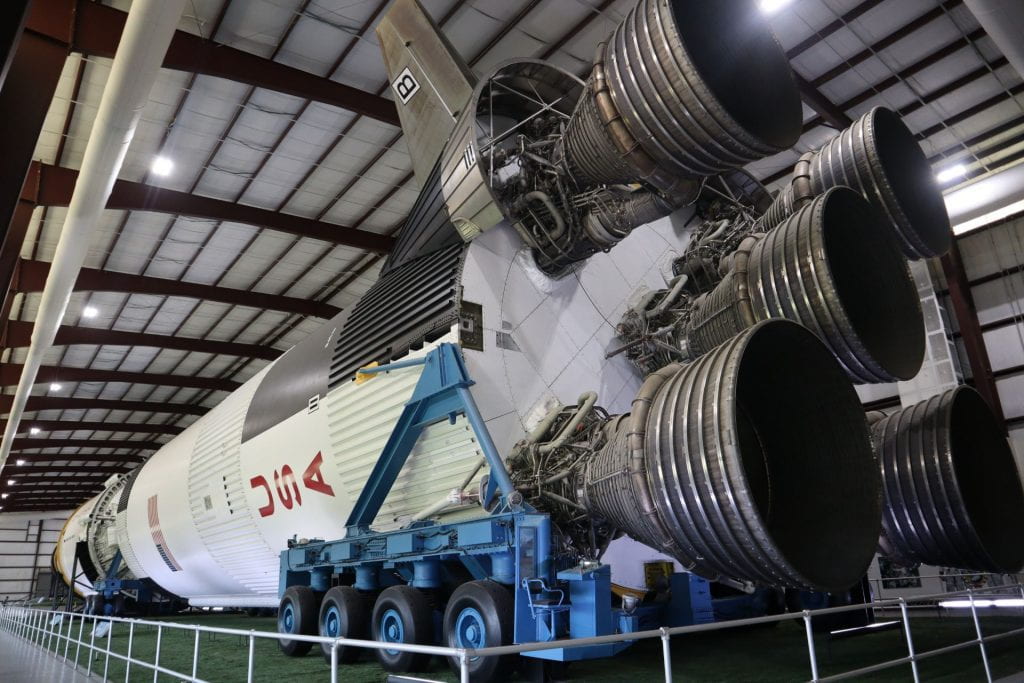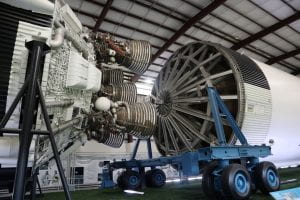DOIT is your source for everything technology at TXST. We want to share our excitement for technology, and what is more exciting than space? This past week I was fortunate enough to represent Texas State University and be one of a handful of people invited to “State of NASA” event at Johnson Space Center – fun fact, the center is named after our presidential alumni LBJ.
Rocket Park
First on the agenda was going to Rocket Park to see the illustrious and titanic Saturn V. The Saturn V is the most powerful rocket ever brought to operational status. It took humans beyond low-earth orbit to the Moon. It, however, will soon be surpassed that by the Space Launch System that NASA is currently developing and is slated to launch in 2021 on the Artemis 1 mission. We then had the opportunity to watch the State of NASA event and learn about the 12% increase in NASA’s budget that will enable the next generation of space exploration and sustainable architecture to go back the Moon to stay.
Mission Control
Right after the State of NASA event we went to see the Mission Control Center where a flight control team was practicing a simulation launch of the Artemis 1 mission to the moon. Flight Director Mary Lawrence came to answer questions. Her response to the question “what piece of advice she would give herself, knowing what she knows now, back in college?” is in the video below.
Building 9
Building 9 is the Space Vehicle Mockup Facility home to the mockup of the Orion spacecraft, Gateway command and service module, and much more. In front of the Orion spacecraft, Director of Johnson Space Center Mark Geyer and newly appointed Director of Human Space Flight Douglas Loverro were taking questions about NASA. Watch the video below of the two directors talking about what they are most excited about in NASA’s future.
Orion Space Capsule
At the Orion spacecraft, we spoke with Heather Paul, Orion Crew and Service Module Health and Medical Technical Authority. We asked her questions as we sat in commander and pilot seats of the Orion spacecraft that will take people to the Moon’s orbit.
Gateway
Gateway is the command and service module that the Orion spacecraft will attach to. Gateway, will orbit the moon and allow humans to land and return from the lunar surface. One of the real innovations with Gateway is that it has solar electric propulsion capability, allowing it to move in Moon’s orbit allowing us the maneuverability to land anywhere on the moon. We had the opportunity to go inside the Gateway Mockup and see how all of the space inside Gateway had a purpose. They even had a reverse air-hockey table that would allow things like food to stick to the table and not float around.
Neutral Buoyancy Lab
The Neutral Buoyancy Lab is an astronaut training pool where astronauts can train in neutral buoyancy meant to simulate the effects of Space. Astronauts will train for International Space Station Space Walks and will soon start training for Artemis missions. We were fortunate enough to be given a tour of the Neutral Buoyancy Lab by Astronaut Andrew J. Feustel who has been to space three times. Including the last Space Shuttle mission and the last maintenance service of the Hubble telescope. In addition, he is also an Instructor Astronaut for EVA Training at the Neutral Buoyancy Lab with 61 hours of logged spacewalk time.
The technology and training that NASA is developing are awe-inspiring. It was incredible to hear from people who are building the technology to go back to the moon. Enjoy this last video that shows Director of Human Space Flight Doug Laverro talking about the excitement for space and technology.
Cedrik Chavez is a student employee in the IT Marketing and Communications office.



